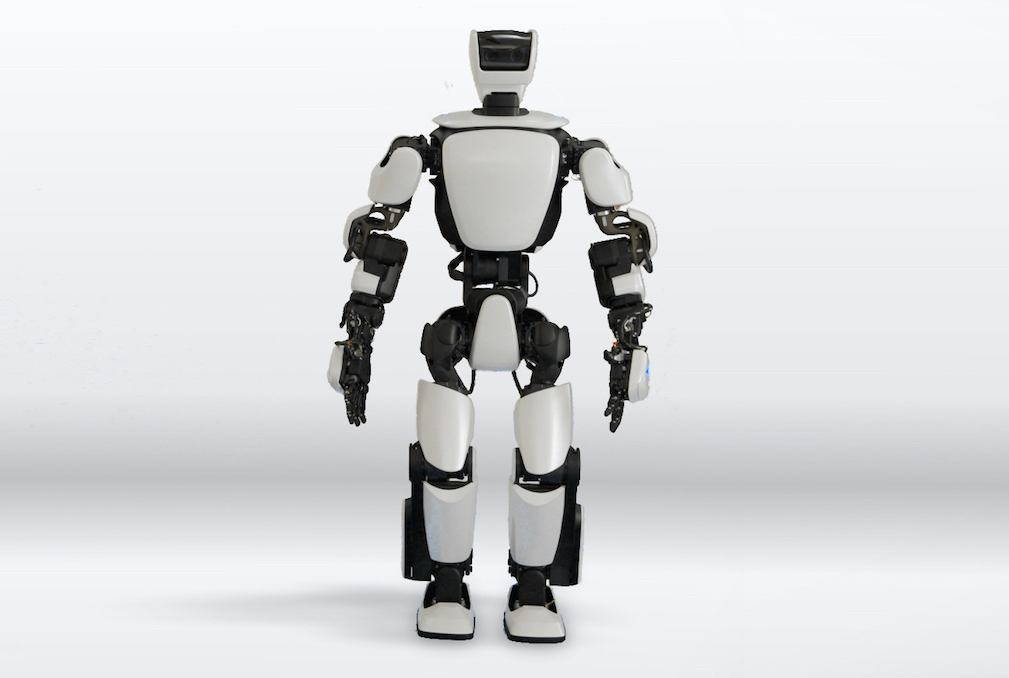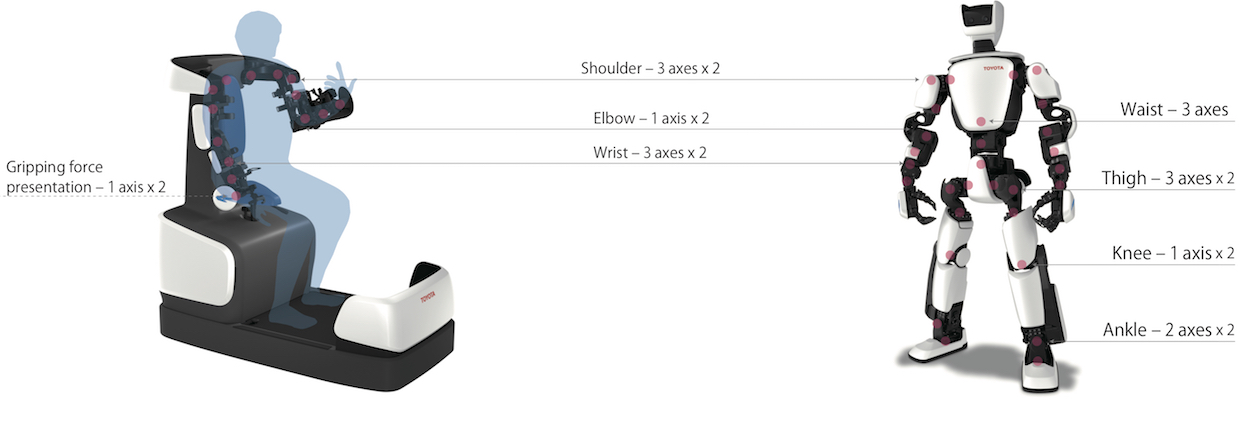Toyota introduced the new humanoid robot T-HR3

Probably the most notable success in robotics, namely in the creation of autonomous walking robots, is made by Boston Dynamics . But not only she, but also her “colleagues” is working in this direction. For example, Toyota, who recently introduced a new humanoid robot T-HR3. His height is one and a half meters, weight - 75 kilograms. He has 32 degrees of freedom and 10 fingers. Plus, this system is able to repeat all the movements of the operator. All this was made possible by creating what the developers called the “Master Maneuvering System”.
Until the announcement of this robot, almost nothing was heard. All information was provided to the public at the time of the announcement. At the same time, the main capabilities of the robot were shown.
The company says that T-HR3 belongs to its third generation of automatic systems. It was created in the laboratories of the Partner Robot Division. A robot can do a lot, but its main purpose is to enable people to learn how to interact with robotic systems, as well as how the robot responds to the environment and various external factors.
According to the company, T-HR3 is a new generation of systems introduced earlier, including robot musicians and assistants. One of these robots, who can play the violin, was shown many years ago.
Since then, the capabilities of robots from Toyota have improved significantly. Virtually all previous versions of the robots of the Japanese company were presented 10 years ago or even earlier. Since then, she decided to work in the direction of HSR , that is, to create robots that could be of some benefit to humans. For example, perform some simple chores or bring things. Some time after the announcement of the first humanoid robots, the company froze its projects, but then started working on them again.
T-HR3, according to the company, is able to help a person both at home and, for example, in a hospital, office, or construction site. It can also perform a number of operations (not the most difficult) in places dangerous to humans. Perhaps, after a certain modification it will be used in space. But T-HR3 is still more positioned as a “home” robot capable of helping doctors, patients, the elderly, and people with certain physical or mental disabilities.
In order to make sure that the robot is able to navigate normally in the surrounding space, Toyota has put a lot of effort into assessing external factors. We are talking about sensors, sensors and servos. For example, the company developed the same Torque Servo Modules with Tamagawa Seiki and Nidec Copal Electronics. The developed systems helped the robot to correctly calculate the efforts made, and thanks to new technologies, it maintains balance even when it collides with a wall or other obstacle.

New actuators include electric motors, joints, sensors. All this is very compact, despite the complexity of the design
But why does the company work on humanoid robots, and not, say, robotized systems of a different form? After all, now quite a lot of mobile systems. The same Boston Dynamics works exactly on such robots. In general, Toyota engineers explain this by saying that humanoid robots are ideally suited for any place that is intended for humans. A robot can easily take an object that is made for a person, change the location of the furniture, go through a narrow corridor. Plus, the T-HR3 is controlled by a person, which means that the operator is easier to adapt to the movements of the robot.
The Toyota system has two arms, two legs, a head, and a torso. As mentioned above, the robot is controlled by the Master Maneuvering System. The operator puts it on and makes certain movements that the robot repeats after the person. A man is put on his head by a video helmet, which shows everything that the robot sees as well. Thus, the person is completely immersed in the virtual space, which is real for the robot. The joints of the robot are bent in the same way as human joints. As soon as the operator makes a movement with his hand or foot, the robot makes a similar movement.
Of course, both the robot itself and the system are very expensive. However, for the time being, these are only experimental designs that may turn into more practical and inexpensive solutions. Another problem to be solved by man is the autonomy of the robot. Yes, he repeats the movements for the operator, but he is unable to make decisions. A plus can be considered that the operator does not need a lot of training. An ordinary person does quite well with the responsibilities of the operator after a short training.
Most likely, the Japanese corporation plans to simply demonstrate the capabilities of robotics, understanding that the current development does not bear any particular practical benefit. But as soon as robots like T-HR3 learn to act offline, such systems will instantly become useful, they can be used in all areas and areas mentioned above.
Future models of autonomous robots are likely to be left to work under the direction of humans. For example, if the AI does not cope with the task, and the robot does not do what is needed, a person can connect to the system who does everything that is needed (for example, he can get the robot out of a complex configuration in which he is stuck). You can think up quite a lot of scenarios of human and robot interaction. In this case, the autonomy of the robot does not have to be 100%. 90-95% is enough for normal system operation.

Now, as mentioned above, the Toyota robot is not as impressive as the creation of Boston Dynamics (especially the one that can jump and do flips). But Toyota does not set itself the task of doing something that BD is developing. True, the systems of this company are not too autonomous. They can avoid obstacles or stand on their feet after falling. But man still controls them with a remote control or something like that.
By the way, the characteristics of Atlas, the maneuverable robot from Boston Dynamics are close to those of Toyota. "Height" - one and a half meters, weight - the same 75 kilograms. He is able to carry a load of 11 kg. The energy source is the battery. The Atlas drive is hydraulic, and it is oriented in space with the help of LiDAR and stereo cameras. Joints 28 has joints, so he also has a large degree of freedom in movement.
Atlas is currently the latest generation of BD robots. He is able to simultaneously coordinate movements of the arms, torso and legs. Interestingly, when creating a robot, developers use 3D printing. Of course, the cameras and servos on the printer can not be printed, but the design of the system contains a large number of parts printed using a 3D printer. The robot is not only able to maintain balance after shocks (like previous models), but also rises after a fall.
The company Toyota, in turn, is not too distributed as to what it plans to do in the future with the T-HR3. “The Partner Robot team will use the technologies involved in T-HR3 to develop robot assistants to help people with their daily tasks,” said Akifumi Tamaoki, a spokesman for the Toyota Partner Robot Division. “We are trying to look ahead, and the key technologies developed for this platform will help to further develop more advanced robots.”
And Boston Dynamics has a new "beast" - SpotMini. At the moment, it is the quietest, but very maneuverable robot, which is now able to take and move objects using a manipulator with five degrees of freedom and pressure sensors.
T-HR3 will be on display along with other robots at the International Robot Exhibition 2017 . This show will be held in Tokyo Big Sight from November 29 to December 2. Robotics are now moving forward at a fairly rapid pace. With the advent of AI, it has become possible to provide a certain degree of autonomy for electronic systems, so there is hope that we will soon be able to see how this or other robots can move independently.
All Articles